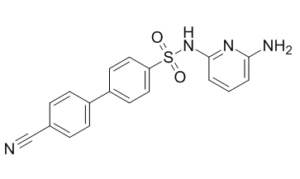This product is for research use only, not for human use. We do not sell to patients.

| Size | Price | Stock |
|---|---|---|
| 5mg | $100 | 3-6 Days |
| 10mg | $150 | 3-6 Days |
| 25mg | $250 | 3-6 Days |
| 50mg | $450 | 3-6 Days |
| 100mg | $750 | 3-6 Days |
| 250mg | $1280 | 3-6 Days |
| 500mg | $1850 | 3-6 Days |
Cat #: V2947 CAS #: 857290-04-1 Purity ≥ 98%
Description: PF-915275 (PF915275) is a novel and selective inhibitor of human 11β-hydroxysteroid dehydrogenase type 1 (11betaHSD1) with Ki of<1 nM and good pharmacokinetics. 11betaHSD1 play a key role in ligand-induced activation of the GR through the production of cortisol. Evidence from genetically modified mice suggests that inhibition of 11betaHSD1 might be a therapeutic approach to treat the metabolic syndrome. PF-915275 maintains potency in our cellular assay against human 11βHSD1 (HEK293, EC50 = 5 nM) and is selective against human 11βHSD2 (HEK293, 1.5% inhibition 10 μM). PF-915275 displays only weak affinity for the rodent choline transporter (Ki = 9.6 μM) and the hamster melatonin MT3 receptor (Ki = 9.6 μM) in the Cerep Bioprint screening panel. PF-915275 has good in vitro pharmacokinetic properties.
Publications Citing InvivoChem Products
Product Promise

- Physicochemical and Storage Information
- Protocol
- Related Biological Data
- Stock Solution Preparation
- Quality Control Documentation
| Molecular Weight (MW) | 350.39 |
|---|---|
| Molecular Formula | C18H14N4O2S |
| CAS No. | 857290-04-1 |
| Storage | -20℃ for 3 years in powder form |
| -80℃ for 2 years in solvent | |
| Solubility In Vitro | DMSO: ≥ 31 mg/mL |
| Water: <1 mg/mL | |
| Ethanol: <1 mg/mL | |
| Synonyms | PF915275; PF 915275; PF-915275 |
| Protocol | In Vitro | In vitro activity: PF-915275 is a novel and selective inhibitor of human 11β-hydroxysteroid dehydrogenase type 1 (11betaHSD1) with Ki of<1 nM and good pharmacokinetics. 11betaHSD1 play a key role in ligand-induced activation of the GR through the production of cortisol. Evidence from genetically modified mice suggests that inhibition of 11betaHSD1 might be a therapeutic approach to treat the metabolic syndrome. PF-915275 maintains potency in our cellular assay against human 11βHSD1 (HEK293, EC50 = 5 nM) and is selective against human 11βHSD2 (HEK293, 1.5% inhibition 10 μM). PF-915275 displays only weak affinity for the rodent choline transporter (Ki = 9.6 μM) and the hamster melatonin MT3 receptor (Ki = 9.6 μM) in the Cerep Bioprint screening panel. PF-915275 has good in vitro pharmacokinetic properties. Kinase Assay: PF-915275 maintains potency in our cellular assay against human 11βHSD1 (HEK293, EC50 = 5 nM) and is selective against human 11βHSD2 (HEK293, 1.5% inhibition 10 μM). PF-915275 displays only weak affinity for the rodent choline transporter (Ki = 9.6 μM) and the hamster melatonin MT3 receptor (Ki = 9.6 μM) in the Cerep Bioprint screening panel. |
|---|---|---|
| In Vivo | Adult cynomolgus monkeys were administered either vehicle or various doses of PF-915275 followed by a 10-mg/kg dose of prednisone. Prednisone conversion to prednisolone and the concentrations of PF-915275 were measured by liquid chromatography/tandem mass spectrometry. PF-915275 dose-dependently inhibited 11betaHSD1-mediated conversion of prednisone to prednisolone, with a maximum of 87% inhibition at a 3-mg/kg dose. An exposure-response relationship was demonstrated, with an estimated EC(50) of 391 nM (total) and 17 nM (free). Insulin levels were also reduced in a dose-related manner. These results should enable the development of a biomarker for evaluating target modulation in humans that will aid in identifying 11betaHSD1 inhibitors to treat diabetes and other related metabolic diseases. | |
| Animal model | Adult cynomolgus monkey |
| Solvent volume to be added | Mass (the weight of a compound) | |||
|---|---|---|---|---|
| Mother liquor concentration | 1mg | 5mg | 10mg | 20mg |
| 1mM | 2.8540 mL | 14.2698 mL | 28.5396 mL | 57.0793 mL |
| 5mM | 0.5708 mL | 2.8540 mL | 5.7079 mL | 11.4159 mL |
| 10mM | 0.2854 mL | 1.4270 mL | 2.8540 mL | 5.7079 mL |
| 20mM | 0.1427 mL | 0.7135 mL | 1.4270 mL | 2.8540 mL |
This equation is commonly abbreviated as: C1 V1 = C2 V2
- (1) Please be sure that the solution is clear before the addition of next solvent. Dissolution methods like vortex, ultrasound or warming and heat may be used to aid dissolving.
- (2) Be sure to add the solvent(s) in order.




































